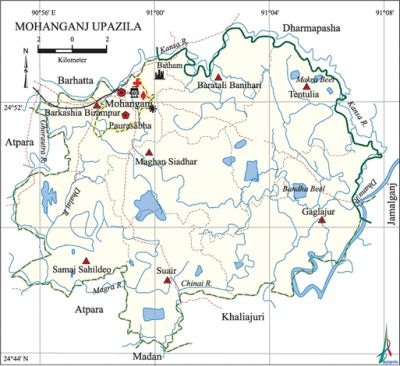Mohanganj Upazila
Mohanganj Upazila (netrokona district) area 241.98 sq km, located in between 24°45' and 24°55' north latitudes and in between 90°55' and 91°07' east longitudes. It is bounded by barhatta and dharmapasha upazilas on the north, atpara, madan and khaliajuri upazilas on the south, jamalganj and Khaliajuri upazilas on the east, Atpara upazila on the west.
Population Total 167507; male 84223, female 83284; Muslim 140855, Hindu 26502, Christian 92 and others 58.
Water bodies Main rivers: Dhalai, Magra, Kansa, Dhanu, Ghorautra, Chinai; Bandha Beel and Makra Beel are notable.
Administration Mohanganj Thana, now an upazila, was formed on 6 April 1920.
| Upazila | ||||||||
| Municipality | Union | Mouza | Village | Population | Density (per sq km) | Literacy rate (%) | ||
| Urban | Rural | Urban | Rural | |||||
| 1 | 7 | 115 | 163 | 27193 | 140314 | 692 | 65.8 | 37.3 |
| Municipality | ||||||||
|
Area (sq km) |
Ward |
Mahalla |
Population |
Density (per sq km) |
Literacy rate (%) | |||
| 6.97 | 9 | 18 | 27193 | 3901 | 65.8 | |||
| Union | ||||
| Name of union and GO code | Area (acre) | Population | Literacy rate (%) | |
| Male | Female | |||
| Gaglajur 31 | 10831 | 9658 | 9418 | 34.5 |
| Tentulia 84 | 9898 | 9375 | 9412 | 29.2 |
| Barkashia Birampur 10 | 5338 | 9909 | 9520 | 42.0 |
| Baratali Banihari 21 | 6403 | 10134 | 9879 | 41.6 |
| Maghan Siadhar 42 | 9177 | 10913 | 11010 | 39.8 |
| Samaj Sahildeo 63 | 7857 | 11086 | 11095 | 33.1 |
| Suair 73 | 8571 | 9512 | 9393 | 40.8 |
Source Bangladesh Population Census 2011, Bangladesh Bureau of Statistics.

Archaeological heritage and relics Ancient fort at village Betham (Sultan Alauddin Hussain Shah period), Shekher Bari Mosque (Hussain Shah period), Daulatpur Temple (876 BS).
War of Liberation The freedom fighters made a surprise attack on the Pak army at Mohanganj Police Station and forced them to flee towards Barhatta Upazila. The freedom fighters then took control over the Police Station. On 8 December the freedom fighters, in collaboration with the local people, killed 19 razakars at Patharghata of Mohanganj.
For details: see মোহনগঞ্জ উপজেলা, বাংলাদেশ মুক্তিযুদ্ধ জ্ঞানকোষ (Encyclopedia of Bangladesh War of Liberation), বাংলাদেশ এশিয়াটিক সোসাইটি, ঢাকা ২০২০, খণ্ড ৮।
Religious institutions Mosque 217, temple 32.
Literacy rate and educational institutions Average literacy 42.1%; male 43.4%, female 40.8%. Educational institutions: college 2, secondary school 8, primary school 50, school 46, madrasa 5. Noted educational institutions: Mohanganj Degree College (1969), Mohanganj Mohila College (1998), Mohanganj Government Pilot High School (1931), Mohanganj Public High School (1981).
Cultural organisations Library 4, club 36, cinema hall 3, women organisation 4, playground 12, theatre group 1.
Main sources of income Agriculture 67.75%, non-agricultural labourer 2.87%, industry 0.80%, commerce 11.87%, transport and communication 2.80%, service 4.30%, construction 0.86%, religious service 0.46%, rent and remittance 0.28% and others 8.01%.
Main crops Paddy, jute, mustard, cotton.
Extinct or nearly extinct crops Potato.
Main fruits Mango, jackfruit, blackberry.
Fisheries, dairies and poultries Fishery 50,' poultry 61.
Communication facilities Pucca road 78 km, semi-pucca road 4 km, mud road 205 km; railway 38 km; waterway 50 km.
Extinct or nearly extinct traditional transport Palanquin, horse carriage, bullock cart, buffalo cart.
Noted manufactories Flour mill, saw mill, rice mill, oil mill, ice factory, printing press, welding factory.
Cottage industries Goldsmith, blacksmith, potteries, embroidery, wood work.
Hats, bazars and fairs Hats and bazars are 38, fairs 2, most noted of which are Mohanganj Hat,' Chhesrakhali Hat, Mathura Hat, Jainpur Hat, Betham Hat, Gaglajur Hat, Paikura Hat, Palgaon Hat, Nagdora Mela and Barantar Mela.
Main exports Paddy, dry fish, egg.
Access to electricity All the wards and unions of the upazila are under rural electrification net-work. However 38.1% of the dwelling households have access to electricity.
Sources of drinking water Tube-well 91.7%, tap 1.3% and others 7.0%. The presence of arsenic has been detected in 33% of the shallow tube-well water of the upazila.
Sanitation 36.6% of dwelling households of the upazila use sanitary latrines and 55.2% of dwelling households use non-sanitary latrines; 8.2% of households do not have latrine facilities.
Health centres Upazila health complex 1, family planning centre 7, satellite clinic 2.
NGO activities Operationally important NGOs are brac, proshika, asa, Ahsania Mission. [Syed Marufuzzaman]
References Bangladesh Population Census 2001 and 2011, Bangladesh Bureau of Statistics; Cultural survey report of Mohanganj Upazila 2007.
